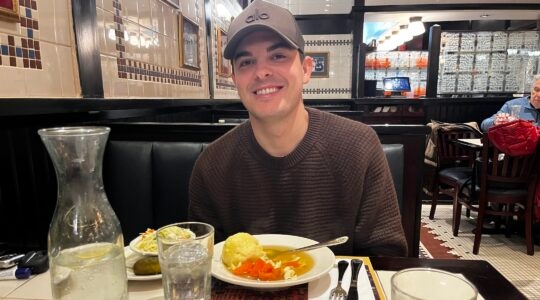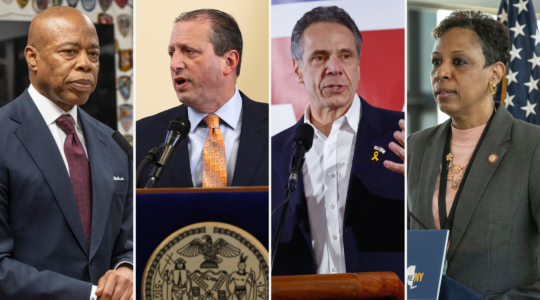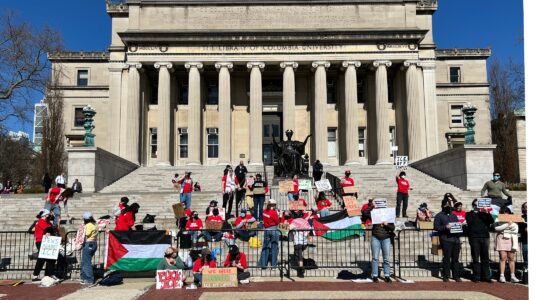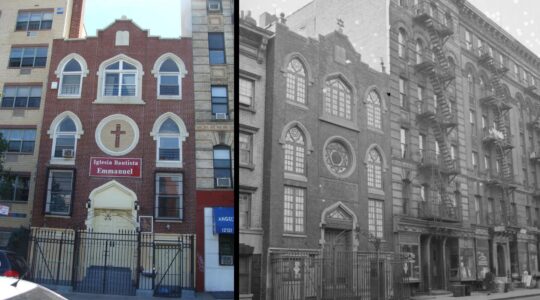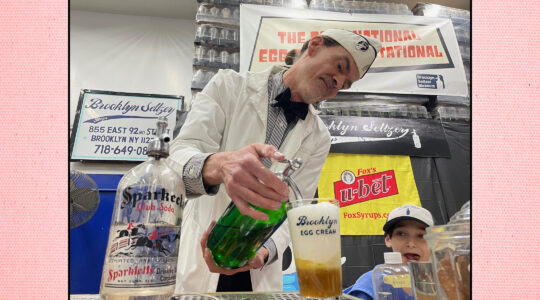NEW YORK — Gift-wrapped and with a colorful bow, Amazon’s got the greatest Hanukkah present any of us could ask for. “The Marvelous Mrs. Maisel” is back, and the second season of the rapid-fire comedy set in the magical, make-believe world of elegant department stores and enormous Upper West Side apartments is just as funny as the first.
Well, I can’t absolutely confirm that. I’ve only seen the first two (of 10) episodes, but they are great. (All 10 drop on December 5.) Midge Maisel (Rachel Brosnahan) and her father, Prof. Abe Weissman (Tony Shalhoub) race off to Paris, where his wife Rose Weissman (Marin Hinkle) is having some sort of life crisis that means living in a shabby room where she has to keep milk and butter on a window sill.
If for some reason you haven’t seen the series (which is on Amazon’s video service), the adorable and sharp-witted Midge is a newly-separated young mother in 1959 with a secret desire, scratch that, secret need to perform stand-up comedy. The first season tracks her entrance into the world of Greenwich Village coffee shops and the bottom-rung of showbiz, with her equally funny (though far more gruff) manager Susie (Alex Borstein) providing two-steps-forward-one-step-back assistance.
It’s the funniest show out there, and certainly the only one with mezuzah jokes.
I had the good fortune to speak, albeit briefly, with Amy Sherman-Palladino, the creator, principle writer and sometimes director of the show, as well as her husband Daniel Palladino, who also writes and directs some episodes. Amy, an extremely stylish woman (be sure to make it to the bottom of this interview for more on that) is refined and elegant, though reserves the right to drop an F bomb when necessary. She certainly has shades of both Midge and Susie in her.
When the PR handlers introduced me as a reporter from The Times of Israel, both Amy and Dan asked if I’d just flown in. “Actually, I live in Queens,” I said. “The other Holy Land,” Amy shrugged as we sat down.
An edited transcript of our conversation is below.
Is this the most Jewish television show in history?
Amy Sherman-Palladino: Hmmn, is it? It’s not more Jewish than “Brooklyn Bridge.”
Daniel Palladino: “Brooklyn Bridge” [on CBS from 1991–1993 – ed.] was so Jewish it became cliché.
Amy Sherman-Palladino: Marion Ross was in it. It was kinda lovely, though.
Daniel Palladino: David Goldberg was the creator. Or Larry Goldberg. Or, oh, what was his name? He’s since passed away, and I …
Amy Sherman-Palladino: Larry David Goldberg? Or, wait, it was, ahhhhh…
I’ll look it up, don’t worry.
Amy Sherman-Palladino: Some Jew! Some Jew made the show. [Gary David Goldberg was the creator of “Brooklyn Bridge” as well as “Family Ties” and “Spin City” – ed.]
Daniel Palladino: It was great, and we loved it. Amy’s parents are Jewish and I worked in comedy –
Amy Sherman-Palladino: An honorary Jew.
Daniel Palladino: We were married by a rabbi, I stepped on the glass. So, showing the culture and the joys and also the travails of a Jewish family is one aspect of the show. We follow her becoming a comedian, but it’s also the Jewish cultural parts of the show. It’s a big flavor. We love our synagogue scenes, and there will be another in Season Two.
Amy Sherman-Palladino: My whole cadence is from my father, he was Borscht Belt, Bronx-Jewish, Mel Brooks “2000 Year Old Man.” So, for me, Jews created humor. And at this time they really created humor. That inflection, that rhythm, the [snaps fingers] “oy” and the “thing,” it’s New York, and it’s Jews. So, if she is going to go into this world, you can’t pretend that it’s not a Jewish world.
She had to come from a Jewish family and she had to be around that flavor, that energy. And this brings us an opportunity to bring Joel’s character is, which is a different type of Jewish family, and see that world.
So, I don’t know that we intentionally set out to “Jew-up television” but [in Yiddish accent] if you gonna’ do it, you do it!
You mention the cadence. When you are writing the patter, like, for example, Season 1 when Susie first sees the palatial apartment, and it’s just a machine gun of jokes, are you walking around your office, talking it out?
Amy Sherman-Palladino: It’s just “in the zone.”
Daniel Palladino: That example, of Susie living in a shoebox downtown and seeing that apartment, it was something that we wrote around the sets we had. It was so “Alice in Wonderland” for her to see one grand apartment, go upstairs and see another, see a maid, so we wanted her to have a big introduction to Midge’s “Kingdom.” In the writer’s room, we broke it down like “first she goes here and sees this, then she’ll walk here and see that.” Then Amy took that, sat down, and wrote all that funny stuff.
Amy Sherman-Palladino: When I write – and I am a terrible typist, by the way. I am completely unskilled and have no qualifications for this job whatsoever. It’s absurd that I ended up a writer. I was supposed to be a dancer, and to be a dancer it doesn’t even matter if you can read so long as you don’t eat.
But for me, it just comes out. And then it’s like “where is the end of the sentence?” I have no idea. It just comes out. In the writer’s room, some times, we play with roles and pitching and the pitching becomes the monologue, then we tape it. It just happens as an explosion. It isn’t clean. I don’t sit down, puff a cigarette and [mimes typing].
What’s the ratio of jokes you write that don’t make it into the show?
Daniel Palladino: It’s close to one-to-one.
Really??!
Daniel Palladino: We break the stories as best we can in the room, or Amy and I together, then we go off and write our individual scripts. There’s not a lot of time to come up with extra material. And our scripts are 80 pages; the average one-hour show is 55. We do have a small staff that will punch up stuff. They take something that’s funny and make it a little funnier.
Amy Sherman-Palladino: We’re a little different, you and I. You are more organized –
Daniel Palladino: And a better typist, too!
Amy Sherman-Palladino: Definitely, but for me if a scene is four pages, I’ll write 15. Then it’s a case of condensing it down, and when it’s done you have all your best jokes.
Season 1 is perfect. And it ends with an absolute emotional and visual slam dunk. Was there ever a secret longing, maybe, to just end it there?
Amy Sherman-Palladino: No.
Never?
Amy Sherman-Palladino: You don’t get into this to do eight episodes, for fuck’s sake!
That’s why I’m asking? I ask the questions, you give the answers!
Daniel and Amy Sherman-Palladino: [Simultaneously] We were already planning the next season during the first!
Okay, okay.
Amy Sherman-Palladino: We didn’t have a moment to step back and say, “We’re so great! Should we fuck it up now?” We finished it, had two weeks of vacation, then were back at work. From the first season we knew we wanted to do Paris, we wanted to do the Catskills. It flowed.
Yes, the show goes to Paris, and I’ve seen that in the first two episodes already. So my big question: when will Mrs. Maisel come to Israel?
Amy Sherman-Palladino: We have discussed it.
Daniel Palladino: We have discussed it. We have to figure out who will allow us to shoot and where we can go that looks like 1960, 1961. That’s always the issue. Can we get into places, and can we come up with story in the places that we can get into? Those are the basics.
But we would love to. It feels like a natural. But we’d have to do a bit of research about the politics going on back then.
Eh, politics in Israel is super simple.
Daniel Palladino: Yes, I understand it has been very calm and stable for the last 70 years.
By the way I took the subway this morning and there were big “Mrs. Maisel” posters right on the 5th Avenue station by this hotel! How ’bout that?
Amy Sherman-Palladino: I love that!!
Do you two live here, or in Los Angeles?
Amy Sherman-Palladino: Here. In Brooklyn.
Okay, so my question is, are there still pockets left of Mrs. Maisel’s world here in New York? Or anywhere, really? Be it the look, the vibe, the attitude?
Daniel Palladino: There are still families on the Upper West Side for whom their building is their world. They don’t ever move out of the building.
Amy Sherman-Palladino: There is a territorial feeling up there. They raise their kids, the kids stay there. We grew up in California and there’s none of that. In California we can’t wait to get away from everybody. Drive somewhere else!
Daniel Palladino: And some places – we mention Keen’s Steakhouse. We mention Peter Luger’s. Those vibes are similar, even if the prices are higher. Central Park has pockets. When you look up, the building facades are the same. Our problem shooting are the lights and bike lanes and ATMs.
Amy Sherman-Palladino: The real place in our show is the Garment Center. And that’s a real building we shoot, in Brooklyn. A functioning factory. The guy who owns it was taught in the Camps. He was taught how to be a tailor. That’s what saved him. He was a young boy, and someone said, “If you want to survive you need to learn a trade that they need.”
Daniel Palladino: He was at Auschwitz at age 12. Martin Greenfield is his name. They are located in Brooklyn. He’s made suits for presidents and celebrities, and he has this incredible story, coming from Auschwitz to America. Where we shoot is his workshop and a lot of the people that you see on camera are his workers. They know how to work those machines. We don’t dress that set much, that’s how it looks.
Wow, that’s incredible. Also incredible is this ring you are wearing, Amy, what exactly is that?
Amy Sherman-Palladino: It’s a pagoda design.
Can I take a photo of that and put it on the Internet?
Yes, yes.
Can I get you in the photo, too.
Just the ring is probably best.
The New York Jewish Week brings you the stories behind the headlines, keeping you connected to Jewish life in New York. Help sustain the reporting you trust by donating today.
